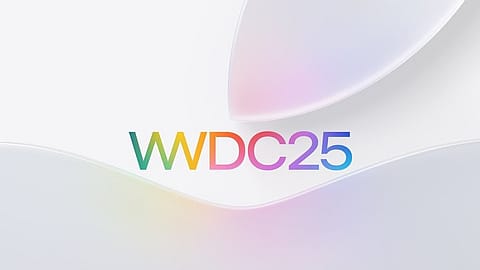WWDC 2025: Apple to stake future on AI with sweeping design refreshes across iPhone, Watch, Vision Pro
WWDC 2025 is not expected to be about moonshot moments. Instead, Apple appears poised to offer a mature, ecosystem-wide upgrade that weaves AI more deeply into its operating systems, refreshes its software design language, and provides developers with more tools to build intelligent, user-focused apps.

Apple is all set to kick off the much-anticipated annual Worldwide Developers Conference 2025 (WWDC), with its keynote presentation broadcasting live from Apple Park. The keynote will begin at 10:30 PM IST and continue until midnight, offering Indian audiences a late-night glimpse into the company’s plans for the year ahead. Viewers can catch the live video stream of the keynote on the company’s official YouTube channel.
This year’s conference comes at a time when Apple faces mounting pressure to prove its relevance in the artificial intelligence space. While the company made bold promises during WWDC24 about its AI ambitions, the months that followed failed to deliver on that excitement. Momentum fizzled out as promised features arrived late or in diminished form.
Tech rivals such as OpenAI and Google have consistently pushed the boundaries with AI tools capable of integrating personal data, generating realistic video content, and delivering highly interactive chatbot experiences that have reshaped user expectations.
As the WWDC25 keynote approaches, here is a lowdown on what all can we expect from the Apple ‘Dub Dub’ this year.
What to expect: AI to be mostly woven into user experience and system-level enhancements
The focus this year is expected to be on steady, strategic upgrades rather than headline-grabbing breakthroughs. While artificial intelligence will take centre stage in Apple’s announcements, analysts suggest the implementation will remain restrained, mostly woven into user experience and system-level enhancements across Apple’s platforms.
According to noted Apple analyst Ming-Chi Kuo, this year’s WWDC will spotlight the company’s AI strategy, but without any revolutionary leaps in the underlying technology. Instead, Apple will look to integrate artificial intelligence meaningfully at the OS level, focusing on elevating user experience rather than dazzling with innovation. Kuo notes that Apple will showcase a complete overhaul of Siri, positioning it under a broader "Apple Intelligence" banner, which will make its presence felt through subtle but useful enhancements in everyday usage.
Recommended Stories
“Apple's on-device AI implementation will likely focus on several aspects: 1) Rebranding Apple Intelligence/Siri, 2) Integrating AI at the OS level to improve overall user experience, 3) Providing tools for third-party developers to incorporate AI into their apps, 4) Strengthening privacy protections through software and infrastructure, and 5) Forming partnerships with more leading AI service providers,” Kuo wrote in a recent post on X.
While expectations for flashy upgrades remain low, Kuo believes Apple can still impress by clearly articulating how its AI features will work on-device and outlining a roadmap that reassures developers and users alike.
“Apple’s existing strengths ensure its hardware can deliver AI services effectively, but they don’t guarantee differentiation or a sustainable competitive advantage in AI.” Kuo added.
Echoing similar sentiments, Bloomberg’s Mark Gurman reports that the event will focus primarily on productivity and design improvements across Apple’s operating systems.
Gurman revealed that Apple is expected to introduce a new version of its foundational large language models, optimised for both on-device and cloud-based processing, with a strong focus on developers. For the first time, third-party app makers will gain access to these models, the same technology powering features like Writing Tools, Genmoji, and document summarisation. This will enable the developers to build their own AI-powered tools.
One major shift, Gurman added, is going to be Apple’s rebranding of its software naming structure, moving away from version numbers and instead adopting a year-based system. This means the next iterations will be labelled iOS 26, iPadOS 26, macOS 26, watchOS 26, tvOS 26, and visionOS 26, all reflecting the 2026 software cycle.
Apart from the above rebranding, the other anticipated changes include a system-wide user interface overhaul, code-named Solarium. Drawing from the Vision Pro’s operating system visionOS, the new Solarium interface is expected to emphasise transparency, light, and “digital glass” elements across iPhone, iPad, Mac, Apple TV, Watch, and even CarPlay. Some core apps are also set for meaningful redesigns, including the Phone app, Safari, and the Camera app.
Yet, most analysts agree that the actual AI updates are expected to be relatively modest and unlikely to match the rapid strides made by rivals such as Google, Meta, Microsoft, and OpenAI.
Just weeks ago, Google showcased its next-generation AI models, enhanced search features, new subscription services, and tools to generate lifelike videos from simple prompts at its own developer conference. Meanwhile, Apple faces growing competitive pressure not just from traditional tech giants, but also from unexpected quarters.
Former Apple design chief Jony Ive has partnered with OpenAI’s Sam Altman to develop next-gen AI hardware, signalling a potential shakeup in the device landscape. At the same time, Samsung is deepening its AI play through a major collaboration with startup Perplexity, aiming to integrate its AI search technology into future flagship smartphones.
In sum, WWDC 2025 is not expected to be about moonshot moments. Instead, Apple appears poised to offer a mature, ecosystem-wide upgrade that weaves AI more deeply into its operating systems, refreshes its software design language, and provides developers with more tools to build intelligent, user-focused apps.